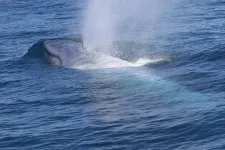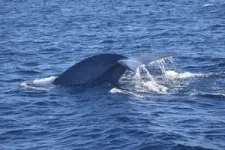(Press-News.org) NEWPORT, Ore. – A new study of New Zealand blue whales’ vocalizations indicates the whales are present year-round in the South Taranaki Bight and their behavior is influenced by environmental conditions in the region.
The findings are a significant advancement in researchers’ understanding of the habitat use and behavior of this population of blue whales, which Oregon State University researchers first identified as genetically distinct from other blue whale populations less than a decade ago.
“We went from not knowing 10 years ago whether this was a distinct population to now understanding these whales’ ecology and their response to changing environmental conditions,” said the study’s lead author, Dawn Barlow, a postdoctoral scholar in OSU’s Marine Mammal Institute. “These findings can inform conservation management of this blue whale population and their habitat.”
The patterns and intensity of the whales’ calls and songs over two years showed strong seasonality in their foraging and breeding behavior, and the vocalizations changed based on environmental conditions such as a documented marine heatwave, Barlow said.
“During the marine heatwave, feeding-related calls were reduced, reflecting poor foraging conditions during that period,” Barlow said. “But we also saw changes in vocalizations in the next breeding period, an indication that they put less effort into reproduction following a period of poor feeding conditions.”
The study was just published in the journal Ecology and Evolution. Barlow conducted the research as a doctoral student in the Geospatial Ecology of Marine Megafauna Laboratory at Hatfield Marine Science Center in Newport, led by associate professor Leigh Torres, a co-author of the new paper.
Blue whales are the largest of all whales and are found in all oceans except the Arctic. Their populations were depleted due to commercial whaling in the early 1900s, and today they are listed as endangered under the International Union for Conservation of Nature’s Red List of Threatened Species.
The New Zealand whales’ habitat overlaps with a wide range of commercial activities, including oil and gas exploration and extraction, vessel traffic, fisheries, wind energy development and possible seabed mining.
Torres first hypothesized in 2013 that the South Taranaki Bight, between New Zealand’s North and South Islands, was an undocumented blue whale feeding ground. Following comprehensive data collection efforts, and using multiple lines of evidence, Torres, Barlow and colleagues were able to document in 2018 that the population in this region was genetically distinct from other blue whale populations.
Previous research was primarily based on observations researchers made during visits to the region in the summer months. But the researchers wanted to know more about the whales’ behavior during other parts of the year. They placed five hydrophones – a type of underwater microphone – that recorded continuously between January 2016 and February 2018, with only brief gaps to retrieve data every six months.
“Unlike many other baleen whales, this population stays in this region year-round,” Barlow said. “That means we can monitor what they are doing from one location. Listening is an effective way to do that.”
The hydrophone recordings showed that the whales’ “D” calls were strongly correlated with oceanographic conditions related to upwelling in the spring and summer. Upwelling is a process where deeper, cooler water is pushed toward the surface; the nutrient-rich water supports aggregations of krill that the blue whales feed on. The whales’ D calls were more intense during periods of strong upwelling.
The recordings also showed that the whales’ song vocalizations, which are produced by males and associated with breeding behavior, followed a highly seasonal pattern, with peak intensity in the fall. That timing aligns with past whaling records’ estimates of conception, Barlow said.
The hydrophone evidence of the breeding behavior and the whales’ presence in the region year-round can influence the animals’ national threat classification status, which impacts management practices, the researchers said.
Blue whales in New Zealand had been classified as migrant, but as a result of the research by Torres, Barlow and colleagues, the classification of has changed from migrant to data deficient. If the whales are reclassified as a resident population, that could impact management practices, but evidence of breeding in New Zealand is needed for that change to occur, the researchers said.
“Although no one has actually documented blue whales mating – it is hard to observe that directly – the increase in song during the expected time of mating is a strong indication of breeding in New Zealand waters,” Torres said. “Our study adds more evidence that these are resident New Zealand blue whales.”
Once the researchers were able to make the link between the whales’ behavior and their calls, they could then look at the calls and behavior relative to environmental patterns. Specifically, they noted how the whales’ foraging and breeding behavior changed during and after a 2016 marine heatwave.
During the marine heatwave, there were fewer aggregations of krill for the whales to feed on, which the researchers documented in a previous study. The reduction in foraging behavior correlated to less intense D calls during that period, and in the next breeding season, the breeding songs were also less intense.
The findings raise additional questions about how changing ocean conditions and human activity in the region are impacting the New Zealand blue whale population and reinforce the need for continued monitoring, the researchers said.
“We have come so far in 10 years in our knowledge of these blue whales - from not knowing this population existed to now understanding their year-round use of this region for feeding, mating and nursing,” Torres said. “New Zealanders should be excited and proud that their country is home to its own unique population of blue whales. We hope our work helps Kiwis manage and protect these whales.”
Additional coauthors are Holger Klinck, director of the Cornell University K. Lisa Yang Center for Conservation Bioacoustics, who also is affiliated with OSU’s Marine Mammal Institute; Dimitri Ponirakis of Cornell; and Trevor Branch of the University of Washington. The Marine Mammal Institute is part of Oregon State’s College of Agricultural Sciences.
END
Blue whale foraging and reproduction are related to environmental conditions, study shows
2023-02-28
ELSE PRESS RELEASES FROM THIS DATE:
Social deficits and seizures in autism type tied to overexcited brain circuits
2023-02-28
· When scientists reduce level of a gene, brain activity and behavior return to normal in mice
· Approach could be used more broadly in other neurodevelopmental disorders
· Neurodevelopmental disorders affect 10 million people in U.S.
CHICAGO --- Northwestern Medicine scientists have identified the cause of a genetic subtype of autism and schizophrenia that results in social deficits and seizures in mice and humans.
Scientists have discovered a key feature of this ...
Adult smokers with mental illness consume the most caffeine in the U.S.
2023-02-28
Americans are drinking more caffeinated beverages than ever before, but Rutgers researchers found one group that tops the charts in caffeine consumption: adult smokers with mental illness.
In a study published online ahead of print in the January issue of the journal Psychiatry Research, Jill M. Williams, director of the division of addiction psychiatry at Rutgers Robert Wood Johnson Medical School, found not only do adult smokers with bipolar disorder and schizophrenia drink the most caffeine, they are at the highest risk of negative health ...
Alternative bladder cancer treatment emerges amid worldwide shortage of standard of care BCG
2023-02-28
An on-going, worldwide shortage of bacillus Calmette-Guérin (BCG) means that many patients with a common and serious type of bladder cancer have limited access to this effective standard of care treatment. But, for the first time in almost 50 years, there appears to be a viable treatment alternative.
A new study from the University of Iowa finds that a safe, inexpensive combo-chemotherapy is better tolerated than BCG and is better at preventing high-grade cancer recurrence in patients with non-muscle invasive ...
Researchers’ model for TV ad scheduling reaps revenue increase for networks
2023-02-28
Whether it’s Flo from Progressive or the Geico gecko, the average TV viewer may not give much thought to commercials outside of whether they’re entertaining or not. However, there is a rather complex science behind what commercials you see and when you see them.
Rensselaer Polytechnic Institute’s Sebastian Souyris, an assistant professor of supply chain and analytics who holds the Dean R. Wellington ’83 Teaching Professorship in Management at the Lally School of Management, along with his ...
Steel was already used in Europe 2900 years ago
2023-02-28
A study by an international and interdisciplinary team headed by Freiburg archaeologist Dr. Ralph Araque Gonzalez from the Faculty of Humanities has proven that steel tools were already in use in Europe around 2900 years ago. Using geochemicalanalyses, the researchers were able to prove that stone stelae on the Iberian peninsula that date back to the Final Bronze Age feature complex engravings that could only have been done using tempered steel. This was backed up by metallographic analyses of an iron chisel from the same period and region (Rocha do Vigio, Portugal, ca. 900 BCE) that showed the necessary carbon content to be proper steel. The result was also confirmed ...
Better metric for prioritizing conservation of “evolutionarily distinctive” species
2023-02-28
An updated metric for prioritizing species’ conservation that incorporates scientific uncertainty and complementarity between species, in addition to extinction risk and evolutionary distinctiveness, is publishing February 28th in the open access journal PLOS Biology, authored by Rikki Gumbs from the Zoological Society of London (ZSL), UK, and colleagues.
In 2007, ZSL established the Evolutionarily Distinct and Globally Endangered (EDGE) metric to prioritise species for conservation based on preserving evolutionary history embodied within endangered species. The approach ...
Parental investment may have aided evolution of larger brains
2023-02-28
A review of evidence from prior research provides new support for the possibility that the evolution of larger brains in some species was enabled through increased energy investment by parents in their offspring. Carel van Schaik of the Max Planck Institute for Animal Behavior in Konstanz, Germany, and colleagues present their arguments in a paper publishing February 28th in the open access journal PLOS Biology.
Between different species, larger relative brain size is associated with cognitive benefits that favor survival. However, larger brains ...
Profiling abortions in low- and middle-income countries
2023-02-28
Multiple factors including a women’s age, marriage status, education and how many living children she has, are associated with pregnancy termination in low- and middle-income countries, according to a new study published this week in the open-access journal PLOS Global Public Health by Djibril Ba of Penn State College of Medicine, US, and colleagues.
In low- and middle-income countries (LMICs), a woman’s decision to terminate a pregnancy is often impacted by a patriarchal structure of society, restrictive abortion laws, cultural and religious beliefs and economic factors. About 45% ...
Hollings researchers develop small molecule to stimulate natural killer cells against neuroblastoma
2023-02-28
An MUSC Hollings Cancer Center research team has created what team members believe to be among the first small molecules designed to stimulate immune cells to fight cancer. More importantly, these compounds inhibit a specific enzyme that hasn’t been targeted with small molecules for the treatment of cancer.
Small molecules are, quite literally, small. They’re hundreds of times smaller than monoclonal antibodies currently used in therapy, and they’re also structurally much simpler. Because of their low molecular mass, they are much more likely to enter cells. Aspirin, for example, is a small molecule ...
'Informal carers’ experienced mental health decline ‘akin to divorce’ during COVID lockdowns
2023-02-28
People who became carers during Covid-19 by helping family members, friends or neighbours in need experienced a sharp decline in their own mental health, new research from Lancaster University reveals.
Using the General Health Questionnaire (GHQ) scale – a psychometrically validated and widely used index of psychological distress – researchers studied individual responses to the UK Household Longitudinal Study (Understanding Society).
They looked at 4698 participants from a total of 11 surveys - three before COVID-19 and eight collected between April 2020 ...






